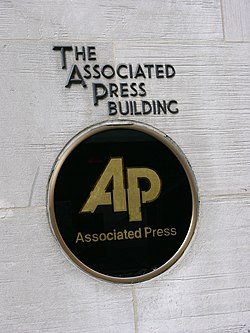Associated Press
From Wikipedia, the free encyclopedia.
- This article concerns the news service. For other uses, see AP (disambiguation).
The Associated Press, or AP, is an American news agency that claims to be the world's oldest and largest. The AP is a cooperative owned by its contributing newspapers and broadcast stations in the United States, who both contribute stories to it and use material written by its staffers. Many newspapers and broadcasters outside the United States are AP subscribers -- that is, they pay a fee to use AP material but are not members of the cooperative.
As of 2005, AP's news is used by 1,700 newspapers, in addition to 5,000 television and radio outlets. Its photo library consists of over 10 million images. The AP has 242 bureaus and serves 121 countries, with a diverse international staff drawing from all over the world.
The collapse of United Press International, AP's traditional rival, has left it as the only nationally oriented news service in the United States. The other rival English-language news services, such as Reuters and the English language service of Agence France Presse, are based outside the United States. It is notable that the AP Stylebook has become the de facto standard for newswriting in the country.

The AP has a straightforward, "just-the-facts" writing style, often using the inverted pyramid style of writing so that stories can be edited to fit a newspaper news-hole without losing the essence of the story. The explosion of media and news outlets with the arrival of the Internet has made such concise writing less necessary, and raised the need for more feature-style writing.
It has also posed a threat to AP's financial structure. On April 18, 2005, at its annual meeting, AP announced that as of 2006 it would, for the first time, begin charging separate fees for posting articles and pictures online. News outlets that buy AP's news, sports, business and entertainment coverage have previously been allowed to place the material online at no extra cost. The cooperative later backed down from the plan and, in a bid to reach more readers, launched asap, a service aimed at 18-34-year-olds.
U.S. employees are represented by the New Media Guild
History
AP was formed in May 1848 by representatives of six competitive New York newspapers, who wanted to pool resources to collect news from Europe. Until then, newspapers competed by sending reporters out in rowboats to meet the ships as they arrived in the harbor. The following year it opened the first bureau outside the U.S., in Halifax, Nova Scotia, to meet ships from Europe before they docked in New York City.
- 1861: Facing censorship in covering the American Civil War, reporters first filed under the anonymous byline "from the Associated Press agent."
- 1876: Mark Kellogg, a stringer, becomes the first AP correspondent to die in the line of duty, at the Battle of the Little Bighorn. His final dispatch: "I go with Custer and will be at the death."
- 1899: AP uses Guglielmo Marconi's wireless telegraph to cover the America's Cup yacht race off Sandy Hook, New Jersey, the first news test of the new telegraph.
- 1914: AP introduces the Teletype, which transmitted directly to printers over telegraph wires. Eventually a worldwide network of 60-word-per-minute Teletypes is built up.
- 1935: AP starts WirePhoto, the world's first wire service for photographs.
- 1941: AP expands from print into radio.
- 1994: AP launches APTV, a global video newsgathering agency.


